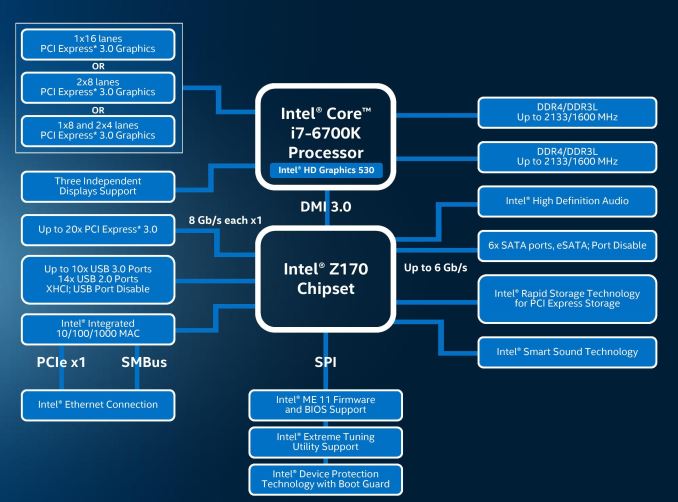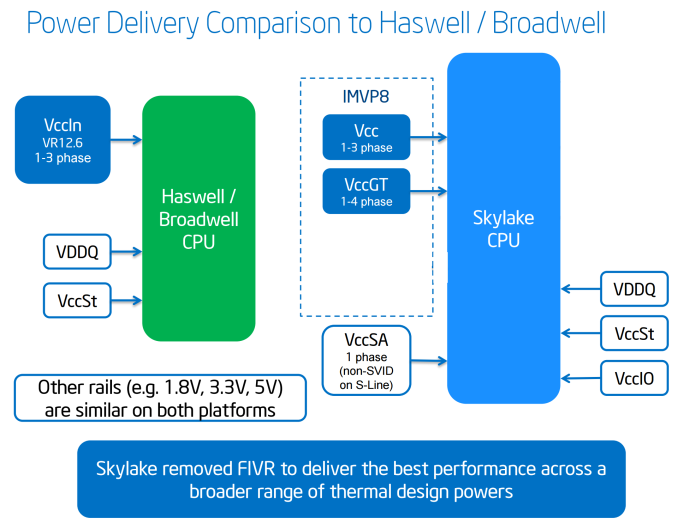The Intel 6th Gen Skylake Review: Core i7-6700K and i5-6600K Tested
by Ian Cutress on August 5, 2015 8:00 AM ESTThe Skylake CPU Architecture
As with any new Intel architecture, the devil is in the details. Previously at AnandTech we have been able to provide deep dives into what exactly is going on in the belly of the beast, although the launch of Skylake has posed a fair share of problems.
Nominally we rely on a certain amount of openness from the processor/SoC manufacturer in providing low level details that we can verify and/or explain. In the past, this information has typically been provided in advance of the launch by way of several meetings/consultations with discussions talking to the engineers. There are some things we can probe, but others are like a black box. The black box nature of some elements, such as Qualcomm’s Adreno graphics, means that it will remain a mystery until Pandora’s box is opened.
In the lead up to the launch of Intel’s Skylake platform, architecture details have been both thin on the ground and thin in the air, even when it comes down to fundamental details about the EU counts of the integrated graphics, or explanations regarding the change in processor naming scheme. In almost all circumstances, we’ve been told to wait until Intel’s Developer Forum in mid-August for the main reason that the launch today is not the full stack Skylake launch, which will take place later in the quarter. Both Ryan and I will be at IDF taking fastidious notes and asking questions for everyone, but at this point in time a good portion of our analysis comes from information provided by sources other than Intel, and while we trust it, we can't fully verify it as we normally would.
As a result, the details on the following few pages have been formed through investigation, discussion and collaboration outside the normal channels, and may be updated as more information is discovered or confirmed. Some of this information is mirrored in our other coverage in order to offer a complete picture in each article as well. After IDF we plan to put together a more detailed architecture piece as a fundamental block in analyzing our end results.
The CPU
As bad as it sounds, the best image of the underlying processor architecture is the block diagram:
From a CPU connectivity standpoint, we discussed the DDR3L/DDR4 dual memory controller design on the previous page so we won’t go over it again here. On the PCI-Express Graphics allocation side, the Skylake processors will have sixteen PCIe 3.0 lanes to use for directly attached devices to the processor, similar to Intel's previous generation processors. These can be split into a single PCIe 3.0 x16, x8/x8 or x8/x4/x4 with basic motherboard design. (Note that this is different to early reports of Skylake having 20 PCIe 3.0 lanes for GPUs. It does not.)
With this, SLI will work up to x8/x8. If a motherboard supports x8/x4/x4 and a PCIe card is placed into that bottom slot, SLI will not work because only one GPU will have eight lanes. NVIDIA requires a minimum of PCIe x8 in order to enable SLI. Crossfire has no such limitation, which makes the possible configurations interesting. Below we discuss that the chipset has 20 (!) PCIe 3.0 lanes to use in five sets of four lanes, and these could be used for graphics cards as well. That means a motherboard can support x8/x8 from the CPU and PCIe 3.0 x4 from the chipset and end up with either dual-SLI or tri-CFX enabled when all the slots are populated.
DMI 3.0
The processor is connected to the chipset by the four-lane DMI 3.0 interface. The DMI 3.0 protocol is an upgrade over the previous generation which used DMI 2.0 – this upgrade boosts the speed from 5.0 GT/s (2GB/sec) to 8.0 GT/s (~3.93GB/sec), essentially upgrading DMI from PCIe 2 to PCIe 3, but requires the motherboard traces between the CPU and chipset to be shorter (7 inches rather than 8 inches) in order to maintain signal speed and integrity. This also allows one of the biggest upgrades to the system, chipset connectivity, as shown below in the HSIO section.
CPU Power Arrangements
Moving on to power arrangements, with Skylake the situation changes as compared to Haswell. Prior to Haswell, voltage regulation was performed by the motherboard and the right voltages were then put into the processor. This was deemed inefficient for power consumption, and for the Haswell/Broadwell processors Intel decided to create a fully integrated voltage regulator (FIVR) in order to reduce motherboard cost and reduce power consumption. This had an unintended side-effect – while it was more efficient (good for mobile platforms), it also acted as a source of heat generation inside the CPU with high frequencies. As a result, overclocking was limited by temperatures and the quality of the FIVR led to a large variation in results. For Skylake on the desktop, the voltage regulation is moved back into the hands of the motherboard manufacturers. This should allow for cooler processors depending on how the silicon works, but it will result in slightly more expensive motherboards.
A slight indication of this will be that some motherboards will go back to having a large amount of multiplexed phases on the motherboard, and it will allow some manufacturers to use this as a differentiating point, although the usefulness of such a design is sometimes questionable.












477 Comments
View All Comments
semyon95 - Wednesday, August 5, 2015 - link
DDR4 is completely useless and it will stay useless for a whileVlad_Da_Great - Wednesday, August 5, 2015 - link
DDR4 should be replaced with 3XP. The new memory from INTC/MU JV. Intel has foreseen that and perhaps next year CPUs models will have huge leap in performance.boeush - Thursday, August 6, 2015 - link
3dXP is much faster than NAND, but still nowhere near as fast as DRAM. So it will never replace DDR.boeush - Wednesday, August 5, 2015 - link
DDR4 is useless at 2133. It won't be quite as useless once 4000+ becomes the affordable norm. It'll take a year or two, but come 2017-18, DDR3 will be a clear-cut dinosaur. Of course, by then HBM 2 and maybe even 3 might be a compelling alternative - if not an upgradeable one...jjj - Wednesday, August 5, 2015 - link
Great , now cut the GPU and sell it at 60-80$ and it's all good.Until then, this is one of the biggest ripoffs in tech.
They do this instead of making a 60mm2 chip (without a GPU) that would cost them 10-20$ depending on yields and could easily retail well bellow 100$ even with their obscene margins. They just add bloat, in fact most of the chip is bloat, just to make it look like you are getting something worth paying for.
richardginn - Wednesday, August 5, 2015 - link
Why cut 80 bucks off it??? The broadwell i7-5775c CPU has GT3e graphics on it and would destroy the crap out of this Skylake CPU for Integrated graphics performance.Skylake is a full on total flop right now!!
Bambooz - Wednesday, August 5, 2015 - link
Except noone gives two sh*ts about integrated graphics when buying an i7..8steve8 - Wednesday, August 5, 2015 - link
I doTeknobug - Wednesday, August 5, 2015 - link
Unless it's in a mini PC type thing like the Gigabyte BRIX or Alienware Alpha. But no I don't buy i7's for its integrated GPU, just gonna say that high end CPU's shouldn't even include iGPU.nikaldro - Tuesday, August 11, 2015 - link
Still, the L4 cache can be useful, and DX12 could make use of both the GPU and iGPU to give better results.I mean, you're charging us 350 bucks, and I want the absolute cutting edge for that much, considering that by next year its 6 core counterpart will cost just a bit more, I think I'll just wait for the skylake E parts